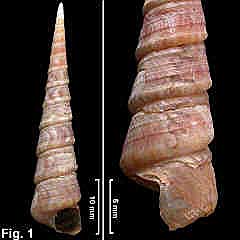|
|
|
|
Gazameda tasmanica (Reeve, 1849) Description: Protoconch 2 whorls, teleoconch 15 whorls in adult shells. Whorls convex or straight sided, suture impressed. Whorls spirally ribbed; latter whorls with a strong, rounded, smooth rib at bottom of whorl, usually overlapping whorl below; with up to 12 riblets above, these variable in strength and spacing. Axial sculpture of dense, curved growth lines over whole surface. Inner lip of aperture reflected outwards weakly at base. Outer lip thin, with sinus. Lip usually broken. Base of body whorl with dense growth lines, not spirally sculptured. Colouration of primary rib cream, sometimes alternating brown and white; rest of whorl fawn or reddish brown, often with diffuse axial brown streaks. Operculum circular, corneous. Size: Up to 62 mm in length. Distribution: Endemic to Australia; southern Queensland around southern Australia to south-western WA. Habitat: Taken in 8 to 150 m.. Common. Comparison: It is often difficult to separate this species from G. gunnii, particularly with worn, faded or broken specimens, as both species are quite variable and overlap in sculptural features. In general, G. gunnii has strong ribs at the upper and lower sutures with a few threads between, while G. tasmanica has a strong rib at lower suture with rest of whorl with numerous riblets. G. tasmanica is a slightly narrower shell than G. gunnii. G. gunnii usually shows wavy axial brown streaks; these are usually absent in G. tasmanica, and when present are more diffuse. Synonymy: The name Turritella subsquamosa Dunker, 1871 was introduced for a form with prominent, undulating lamellate growth striae. Remarks: The sculpture of this species is quite variable. In the typical form, there is a strong spiral rib at the lower suture, usually overlapping the whorl below, and the rest of the whorl bears about 6-12 riblets, more or less evenly spaced and uniform in size. However, specimens occur where the secondary sculpture is absent or very weak, or variable in strength and spacing. In some shells the primary rib is not much stronger than the secondary sculpture, and in others there may be a weak, broad rib at the upper suture. Colouration is almost as variable; the form with a plain cream primary rib and reddish-brown whorls is most common, but shells with axial streaks occur frequently. Fig. 1: Off Newcastle, NSW, in 64-73 m (C.079798). |
